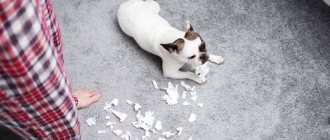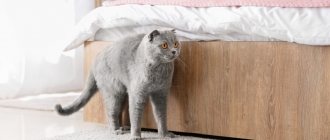What will you learn from the article?
- Why cats scratch furniture and wallpaper Physiological reasons
- Psychological reasons
- Behavioral reasons
- Step 1. Buy a scratching post
Sharpening claws is a natural need of a cat that must be satisfied. Domestic cats are deprived of their natural ability; they sharpen their claws on surfaces that remind them of the structure of wood. Often the choice of pets falls on wallpaper, corners of rooms and furniture.
In this article:
- Let's talk about the reasons why cats sharpen their claws on furniture and wallpaper;
- we will teach you how to stop a cat from tearing up wallpaper;
- We’ll show you how to save furniture from cat claws;
- We will recommend weaning methods and special repellents.
Why do cats scratch furniture and wallpaper?
The main function of scratching claws is to maintain the sharpness of the cat's hunting weapon. But this is not the only reason why a cat scratches wallpaper and tears up furniture.
To get rid of a bad habit, you must first understand the reasons for the unwanted behavior.
Physiological reasons
- Keeping claws sharp. A predator's claws must be sharp so as not to miss its prey.
- Exfoliation of the top dead layer of the claw.
- Claw marks and the smell of secretions released by the paw pads help the animal mark its territory.
- Warm up. When a cat sharpens its claws, it stretches to its full height, stretches its spine and muscles.
- Ritual of communication with other cats. Many animals stretch and scratch their claws in the presence of their fellow tribesmen.
Psychological reasons
The animal's psycho-emotional state pushes it to tear apart the sofa and wallpaper.
A cat scratches if:
- he is jealous. This way he can express his dissatisfaction with the fact that small children or new pets have appeared in the house.
- experiencing stress. A restless environment around the animal serves as a basis for scratching. Cats painfully endure preparations for moving, renovation work in the house, and the appearance of a cat in the next apartment.
- defends its interests and fights for territory. A tense relationship with a new pet or hostility between two cats will inevitably lead to claw marks on furniture and walls. This is how cats mark their territory and spread their scent over it.
- plays. A piece of wallpaper accidentally torn off while scratching a wall can encourage the animal to continue this activity. The hosts' reaction to this incident, even negative, makes the game even more exciting.
- doesn't feel safe. The pet tries to increase its security by spreading its scent throughout the apartment using scratches.
Behavioral reasons
- Lack or lack of education. A kitten scratches furniture and tears wallpaper if it was not taught to use a scratching post from an early age and its attempts to sharpen its claws wherever it wants were not stopped.
- Adult animals may behave inappropriately due to a change in owner, relocation, lack of attention from the owner, or deterioration in living conditions.
Radical methods
If you are desperate to demand order from your cat, and he continues to destroy your things, resort to more radical methods.
Nail trimming
Many owners practice trimming the nails of their pets. The procedure has many advantages:
- The furniture will be intact, because there is no longer any need to sharpen the claws;
- The cat will not scratch you either;
- You will also be safe during all kinds of bathing and ear cleaning;
- It is customary to trim the claws before mating or going to the veterinarian.
If all safety rules are followed, the procedure will not be difficult. The main thing is to neutralize the animal and not harm it. To do this, please have patience, a blanket to wrap the cat in, and special scissors.
Caps
A very strange method, however, effective. A special silicone cap is put on each claw (pre-trimmed). Murka will not be able to sharpen his claws and thereby harm the furniture.
It is not yet known whether this procedure is humane, but the owners are taking full advantage of the innovation.
How to stop a cat from tearing furniture and wallpaper
Don't hold a grudge against cats, don't scold them for ruining wallpaper, carpet and furniture. Animals do this unintentionally, not with the intention of harming the owner. They act at the level of instincts inherent in nature.
To protect furniture, new wallpaper, carpeting, it is necessary to identify the cause of the behavior and eliminate it. If your animal is suffering from stress, seek help from a veterinarian or animal psychologist. If the reasons for scratching are not related to the psycho-emotional state of the pet, be patient to instill good manners in the cat.
Step 1. Buy a scratching post
Buying a scratching post that your cat will like is the best solution to the problem of sharpening its claws in the wrong places. Offer your cat several models, place them in different places. The animal must have a choice. For each pet in the house there should be at least two scratching posts of different textures and directions.
This cat accessory will allow your pet to satisfy its physiological needs. If the animal appreciates the capabilities of the scratcher, then you don’t have to worry about the wallpaper and furniture. Be patient and consistent; it may take several months to train your claws to scratch in the right place.
Read more: how to train a cat to use a scratching post.
Step 2: Create a safe personal space
Scratches on wallpaper and furniture can be a special form of marking and indicate a cat's insecurity. Reasons for concern for a pet may be neighbor's animals entering the area, quarrels between owners, or a conflict between the cat and other pets.
Repairing and replacing furniture is stressful for a cat. During repairs, animal odors that help you feel safe in the house are destroyed. They are replaced by foreign aromas of building materials, new furniture and floor coverings. This worries the pet. The cat scratches things and wallpaper to make the space of the house more friendly, transmitting its smell to it.
How an owner can help an animal feel more confident
- Install cat doors to keep other animals out of your home.
- Monitor relationships between pets. Create for everyone their own resting place, preferably on an elevation, to make it more convenient to observe what is happening in the house. Provide each pet with its own litter tray.
- Give the cat its own place in the house. Create an area for playing and climbing, provide a house in which the animal can hide and be alone.
- Help your cat spread its scent around the house after renovating and replacing furniture. To do this, rub the animal's cheeks with a soft cloth, and then wipe the corners of the house, furniture legs, and door frames with this cloth.
- Never physically punish unwanted behavior. The owner should be a source of security for the cat, and not an additional threat.
Step 3. Trim nails regularly and use anti-scratch guards
Regular cat manicures will protect walls and furniture from sharp claws. If you carefully cut off the dead part of the claw as it grows, then the cat will not have the desire to sharpen its claws again. You can trim your nails at home, using caution. Or entrust this procedure to a professional from a grooming salon.
The Anti-Scratch claw device is another useful accessory that protects the home’s furniture and wallpaper from damage. These soft pads avoid the controversial and very painful declawing procedure. Cats wearing anti-scratch guards will also sharpen their claws, but will not harm any surfaces.
Step 4: Clean scratched areas
When cats use scratches as territorial marks, they return to refresh the mark. To prevent your pet from returning to the scratch site again and again, clean it thoroughly. Try to completely remove the cat odor using detergents and disinfectants.
To stop a cat from scratching the sofa, the soft upholstery is washed with a solution of washing powder and then wiped with an alcohol-containing liquid. While the treatment area dries, the cat should be kept in a separate room. After drying, this place can be additionally treated with a spray with a citrus scent or use a special “Anti-claw” spray.
Step 5. Use aids
You can use strong smells that repel cats to wean your pet from a bad habit. Cats have an excellent sense of smell; strong-smelling substances are unpleasant and repulsive to them. If you spray one of these scents on a surface that your pet uses for sharpening its claws, your cat may give up the habit.
Most often used to wean off scratching:
- citrus aromas;
- acetic acid;
- essential oils (eucalyptus, lavender, lemongrass);
- strong alcohol;
- sharp perfume.
Spraying is carried out using a spray bottle. The repellent is pre-diluted in water. Choose those scents that will not be unpleasant to the owners and will not greatly spoil the smell in the apartment.
Instead of these home remedies, you can use special products to stop cats from scratching. These sprays are sold in pet stores and veterinary pharmacies. Next, we will talk about the best means and their cost.
Another way to protect your furniture is to apply double-sided tape to the scratched areas. Cats do not like sticky surfaces; touching the tape with their paws will be unpleasant for them. The animal will no longer scratch in this place.
Step 6. Choose the right wallpaper
While furniture can be sprayed with professional or homemade repellents to protect against cat claws, wallpaper is more difficult to save. After spraying the “crime scene,” stains and unpleasant stains remain on the wallpaper. In addition, odors from wall surfaces evaporate faster; the procedure will have to be repeated again and again.
What wallpaper to choose if there is a cat in the house:
- non-woven;
- wallpaper with silk-screen printing;
- washable wallpaper.
A real salvation from cat pranks is anti-vandal wallpaper. This is a new wear-resistant type of finishing materials. To enhance the wear resistance of this wallpaper, the manufacturer uses additional external coating and reinforcement.
Types of anti-vandal wallpaper:
- vinyl “anti-claw”;
- fiberglass for painting;
- non-vandal resistant non-woven fabrics for painting;
- laminated;
- textile-based vinyl;
- vinyl on non-woven base.
No covering, even the most stable one, will be able to wean a cat from a bad habit unless you buy him a scratching post and teach him to use it.
hello
This Agreement, in accordance with clause 2 of Art. 437 of the Civil Code of the Russian Federation, is a public offer, the acceptance of the terms (acceptance) of which is the performance of actions provided for in the Agreement.
Definitions
1.1. The terms of the Agreement govern the relationship between the Copyright Holder and the User and contain the following definitions:
1.1.1. Offer - this document (Agreement), posted on the Internet at the address: Internet site address.
1.1.2. Acceptance - full and unconditional acceptance of the offer by performing the actions specified in clause 3.1 of the Agreement.
1.1.3. Copyright holder is the legal entity (Name of the Party) that posted the offer.
1.1.4. User is a legal entity or a legally capable individual who has entered into an Agreement by acceptance on the terms and conditions contained in the offer.
1.1.5. Internet site is a collection of web pages hosted on a virtual server and forming a single structure, located on the Internet at the address: Internet site address (hereinafter referred to as the Site).
1.1.7. A simple (non-exclusive) license is the User’s non-exclusive right to use the result of intellectual activity specified in clause 2.1 of the Agreement, with the Copyright Holder retaining the right to issue licenses to other persons.
Subject of the Agreement
2.2. The Copyright Holder guarantees that he is the copyright holder of the exclusive rights to the Site specified in clause 2.1 of the Agreement.
Agreement with the terms of the agreement
3.1. Acceptance (acceptance of the offer) is the User clicking the “Help” button.
3.2. By taking actions to accept the offer in the manner specified in clause 3.1 of the Agreement, the User guarantees that he is familiar with, agrees, fully and unconditionally accepts all the terms of the Agreement, and undertakes to comply with them.
3.3. The User hereby confirms that acceptance (taking actions to accept the offer) is equivalent to signing and concluding an Agreement on the terms and conditions set forth in this Agreement.
3.4. The offer comes into force from the moment it is posted on the Internet at the address Internet site address and is valid until the offer is revoked.
Rights and obligations of the parties
4.1. The copyright holder undertakes:
I recommend: Too active cat, I have a question for you
4.1.1. Within a period of calendar days from the date of receipt of the corresponding written notification from the User, on our own and at our own expense, eliminate the shortcomings of the Site identified by the User, namely:
— discrepancy between the content of the Site and the data specified in clause 2.1 of the Agreement;
— the presence on the Site of materials prohibited for distribution by law.
4.1.2. Refrain from any actions that could impede the User’s exercise of the right granted to him to use the Site within the limits established by the Agreement.
4.1.3. Provide information on issues related to working with the Site via email, forum, blog. Current email addresses are located in the “Section Name” section of the Site at the address: Internet site address.
4.1.4. Use all personal data and other confidential information about the User only to provide services in accordance with the Agreement, and do not transfer documentation and information about the User in its possession to third parties.
4.1.5. Ensure the confidentiality of information entered by the User when using the Site through the User’s personal account, except for cases where such information is posted in public sections of the Site (for example, chat).
4.1.6. Advise the User on all issues related to the Site. The complexity of the issue, volume, and timing of consultation are determined in each specific case by the Copyright Holder independently.
4.2. The user undertakes:
4.2.1. Use the Site only within the limits of those rights and in the ways provided for in the Agreement.
4.2.2. Strictly adhere to and not violate the terms of the Agreement, as well as ensure the confidentiality of commercial and technical information obtained in cooperation with the Copyright Holder.
4.2.4. Do not use any devices or computer programs to interfere or attempt to interfere with the normal functioning of the Site.
4.2.5. Immediately inform the Copyright Holder about all facts of illegal use of the Site by third parties that have become known to him.
4.2.8. Do not distribute advertising materials in personal messages to other Users without obtaining their prior consent to receive such materials (SPAM).
4.2.9. Perform other duties provided for in the Agreement.
4.3. The copyright holder has the right:
4.3.1. Suspend or terminate the User’s registration and access to the Site if the Copyright Holder reasonably believes that the User is engaged in illegal activities.
4.3.3. Make unilateral changes to the Agreement by publishing its new editions.
4.3.4. Delete user content at the request of authorized bodies or interested parties if this content violates applicable law or the rights of third parties.
4.4. The user has the right:
4.4.1. Use the Site within the limits and in the ways provided for in the Agreement.
Terms and conditions of use
5.2. In accordance with the terms of the Agreement, the Copyright Holder grants the User the right to use the Site in the following ways:
5.2.1. Use the Site to view, review, leave comments and other entries and implement other functionality of the Site, including by displaying the User’s corresponding technical means on the monitor (screen);
5.2.2. Briefly download into computer memory for the purposes of using the Site and its functionality;
5.2.3. Quote elements of the Site's user-generated content, indicating the source of the citation, including a link to the Site's URL.
5.2.4. Method of use: Method of use.
5.3. The User does not have the right to take the following actions when using the Site, as well as any component parts of the Site:
5.3.1. Modify or otherwise process the Site, including translation into other languages.
5.3.2. Copy, distribute or process materials and information contained on the Site, except when this is necessary and caused by the implementation of functionality available to a specific User.
5.4. Any rights not expressly granted to the User in accordance with this Agreement are reserved by the Copyright Holder.
5.5. The Site is provided by the Copyright Holder in “As Is” (“AS IS”) condition, without the Copyright Holder’s warranty obligations or any obligation to eliminate defects, operational support and improvements.
Personal data and privacy policy
Responsibility of the parties
7.1. The parties are responsible for failure to fulfill or improper fulfillment of their obligations in accordance with Russian legislation.
7.2. The Copyright Holder does not accept responsibility for the compliance of the Site with the purposes of use.
7.3. The Copyright Holder is not responsible for technical interruptions in the operation of the Site. However, the Copyright Holder undertakes to take all reasonable measures to prevent such interruptions.
Dispute Resolution
8.1. The claim procedure for pre-trial settlement of disputes arising from this Agreement is mandatory for the Parties.
8.2. Claim letters are sent by the Parties by courier or registered mail with return receipt requested to the Party's location address.
8.3. Sending letters of claim by the Parties in a manner other than specified in clause 8.2 of the Agreement is not permitted.
8.4. The period for consideration of a letter of claim is the period for consideration of working days from the date of receipt of the latter by the addressee.
8.5. Disputes under this Agreement shall be resolved in court in accordance with the law.
Useful tips for cat owners
- Don't rush to throw away your old scratching post. If you purchased a new accessory for sharpening cat claws, place it next to the old claw grinder, which is saturated with familiar odors. Throw away the old one only when the animal gets used to the new one.
- Use the Kuklachev method. To stop a cat from scratching wallpaper, glue a piece of “favorite wallpaper” onto a board and place it in the place where the cat is used to scratching the wall. Every day the board is moved to the place where the scratching post is located.
- Applaud the cat. As soon as the animal begins to sharpen its claws in the wrong place, clap your hands loudly. You can hit the floor with a slipper - it will have the same effect.
- Believe in the power of your word. Sternly say “No!” when the cat starts scratching the furniture or wallpaper. Don't shout, speak confidently. Repeat this command every time your pet is about to sharpen its claws in the wrong place. Over time, he will understand that the owner does not approve of this behavior.
Stroking the fur
Weaning an animal away from what is its natural behavior is not an easy task. Only prohibitions will not help here. To make it clear to the cat that the owner loves him, and you can sharpen his claws not only on wallpaper, you must not forget to praise your purr. If he picks at the scratching post, pet your pet. This way he will understand much faster which behavior is preferable. Scolding a cat is useless. He may harbor a grudge and further damage things and decor in the apartment in order to take revenge on the owner. If you love your cat, you will definitely find out how to gently stop him from sharpening his claws on interior elements.
Means for repelling cats from wallpaper and furniture
In veterinary pharmacies and pet supply stores you can purchase special repellents that can be used to treat furniture, walls, door frames and other places where cats sharpen their claws. The unpleasant smell of these products disgusts cats, and they avoid the treated areas.
Best scratch repellents:
- Beaphar Stop It Cat is an effective spray for repelling cats from wallpaper, furniture and indoor flowers. Price: bottle 100 ml. – 740 – 890 rub.
- Nature's Miracle, JFC Pet Block Cat Repellent Spray is a concentrated spray based on natural repellents. Price: bottle 236 ml. – 440 – 470 rub.
- Spray Mr. Fresh is a means to prevent cats from tearing wallpaper. Suitable for kittens and cats. Price: 200 ml bottle. – 180 – 280 rub.
- Spray lotion VioVax “Repel? Yes!" – based on natural ingredients, protects furniture and walls from scratching. Price: bottle 180 ml. – 123 – 160 rub.
- Api-San Smart spray - protects against chewing and scratching. Price: bottle 200 ml. – 180 – 265 rub.
Reasons for bad behavior
Before you accuse a cat of bad behavior, bad character, vindictiveness and other sins, take it as a fact - not a single cat will spoil its home of its own free will. This applies to scratching furniture, throwing objects, ignoring the litter box, tags and other difficulties that owners have to deal with.
Once you begin to understand the nuances of the physiology and psychology of cats, the reasons for their habits will become clear to you, and this is the first step to weaning your cat from clawing wallpaper and furniture.
How not to wean
It is better not to use these weaning methods if you want to achieve a positive result and remain on good terms with the cat:
- Spray bottle with water. To scare away a cat, taking advantage of its dislike for water procedures, water is sprayed on its face from a spray bottle. This method may work, but the animal will begin to associate this unpleasant event with your personality and will try to take revenge.
- Scream. Remember that you can scold a cat, but you cannot shout at it. Never scream when you stop a cat with a voice command. Screaming will scare the animal, but will not bring the desired result.
- Physical punishment. You can't hit cats! The animal will get scared, harbor a grudge, and try to take revenge.
- Late identification of the problem. You can scold a cat only when you take it by surprise at the site of vandalism. If the wallpaper is already torn off, the furniture is scratched, there is no point in expressing your attitude towards this. The animal will not understand why you are scolding it.
The agony of thought
When an owner hesitates before deciding to get a kitten, questions about its maintenance, nutrition and even treatment are most often not considered. The first, obvious problems will arise immediately after the baby arrives in the house.
Will the kitten go to the litter box? Even inexperienced owners know that it will not be difficult to accustom a cat to cleanliness, since the pet itself strives for cleanliness. The second, overwhelming doubt is the integrity of the wallpaper and furniture. You probably know cat owners who no longer pay attention to tattered wallpaper, curtains, door jambs and a leather sofa in a disastrous state.
You can join the owners who ignore problems, believe me, there are quite a few of them. If this option does not suit you, there are many ways to stop your cat from scratching furniture. However, you need to start with the reasons, that is, finding out the cat’s motivation.
If you correctly understand your pet's needs and allow him to compensate for his desires without harm, no one or nothing will get hurt.
Education is the key to success
Once you have determined your pet's motivation, you can take corrective measures, but the approach must be individualized. Each cat has its own temperament; pets can be touchy and even vindictive. No one except the owner will determine at what point it is necessary to push with authority, and when it is better to retreat.
We must accept it as a fact that a pet will never tear anything out of harm or without reason. Scratching is one of the natural behaviors you take for granted when you decide to get a kitten.
The second fact that you just need to accept is the uselessness of prohibitions. Shout, scold, lock, do whatever you want... you cannot stop a cat from sharpening its claws, it will do it one way or another. Moreover, aggressive actions on your part will only aggravate the problem, since you will let the cat know that you are ready to infringe on its natural needs for the sake of your whim. The true leader of the pack cares about its members, and in return demands obedience.
When making adjustments, you need to use only an integrated approach. Moreover, you will need to be patient and persistent. You will not solve the problem in one day; it may take weeks or even months. However, even small progress is a big victory.











